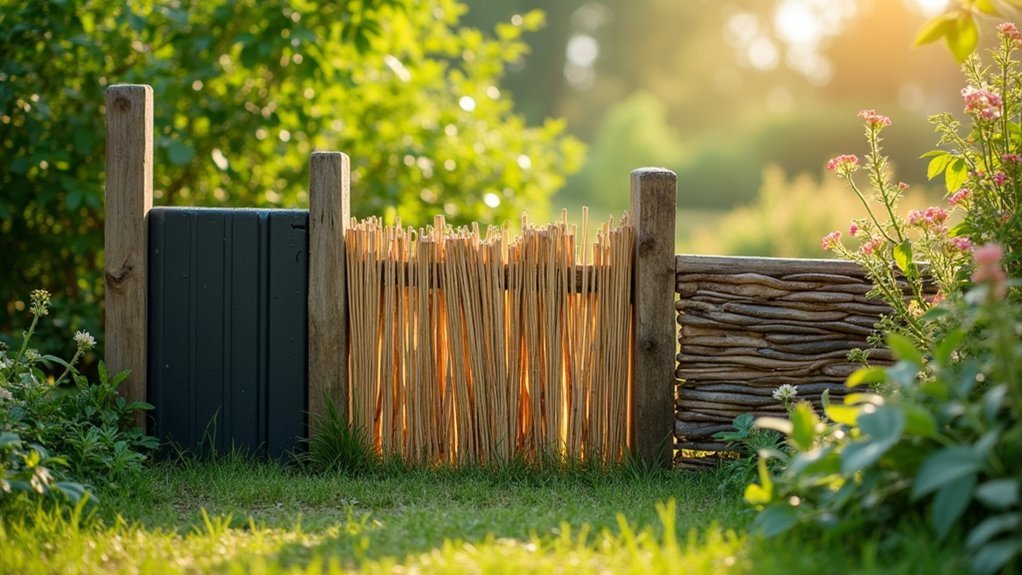For natural fences, your top three root barrier options are HDPE barriers (2mm thickness), rigid panel systems with raised ribs, and recycled polyethylene barriers with UV inhibitors. HDPE offers maximum protection against aggressive species like bamboo and willow, while rigid panels redirect growth away from your fence. Professional installation with proper trenching (24-36 inches deep) guarantees lasting protection. The right barrier choice depends on your specific plant species and climate conditions.
HDPE Barriers: Maximum Protection for Aggressive Root Systems

When searching for effective solutions to contain aggressive root systems in natural fences, High-Density Polyethylene (HDPE) barriers stand out as the premium choice.
These barriers offer exceptional durability with 2mm thickness options that effectively block invasive roots from bamboo, willow, and other aggressive species.
You’ll benefit from HDPE’s impressive temperature resilience (-60°F to 180°F), ensuring your barrier remains functional in extreme weather conditions.
The seamless roll design minimizes potential entry points for determined roots, unlike panel systems with multiple joins.
What makes HDPE particularly valuable is its decades-long underground lifespan due to resistance to rot, chemicals, and UV degradation.
For sustainable landscaping, look for options made from 100% recycled material that remain fully recyclable after their extended service life. For specific product recommendations, the RootBarrier HDPE product line includes several options like RootBarrier 325, 360, and 420UV designed specifically for civil engineering applications.
Rigid Panel Barriers: Integrating Structure With Root Control
Many landscapers consider rigid panel barriers the ideal solution when structural integrity is as important as root control. Made from recycled polyethylene with UV inhibitors, these barriers feature raised ribs that mechanically redirect root growth away from your hardscapes and natural fences.
You’ll find these panels easy to install thanks to their interlocking design, creating seamless protection across large areas. The interlocking, anti-lift panels provide exceptional stability throughout your landscape installation. When installed at an appropriate setback from structures, they effectively guide roots downward while maintaining your landscape’s visual appeal.
They’re particularly effective for protecting foundations, sidewalks, and driveways without compromising the aesthetic of your natural fencing.
Available in various sizes like 18-inch by 24-inch panels, rigid barriers provide long-lasting performance with minimal environmental impact, making them suitable for both residential and commercial projects.
Professional Installation Methods for Long-Lasting Fence Protection

Properly installed root barriers provide considerably longer protection for your natural fences than DIY methods.
Begin by digging trenches 24-36 inches deep, positioning them 3-5 feet from your fence line. This depth effectively manages aggressive root systems while the distance accommodates future growth patterns.
Select high-quality polymers or specialized fabrics that resist degradation, and consider adding protective geomembrane fleece for additional puncture resistance. Professional installation minimizes potential complications and ensures proper depth placement, contributing significantly to the long-term effectiveness of your barrier system.
When installing, guarantee the barrier extends at least 100mm above ground level to block surface roots.
Heat-weld all joints rather than using basic adhesives, and maintain a straight, smooth installation without kinks. Allow slack at corners to prevent tension during backfilling.
After installation, conduct regular inspections to identify any compromise early and monitor soil settlement around your barrier.
Frequently Asked Questions
How Do Root Barriers Affect Soil Moisture and Drainage Patterns?
Root barriers affect your soil by creating moisture zones—permeable ones allow water flow while impermeable ones retain moisture. They’ll redirect drainage patterns, potentially causing compaction and altering natural water movement around your plants.
Can Root Barriers Protect Utility Lines Near Natural Fences?
Yes, properly installed root barriers protect utility lines by deflecting roots downward. You’ll prevent costly damage to plumbing, electrical, and gas lines while still maintaining your natural fence’s health and appearance.
Are Root Barriers Environmentally Friendly and Biodegradable?
Most commercial root barriers aren’t biodegradable, as they prioritize durability. You’ll find they’re environmentally mixed – they preserve mature trees and minimize soil disruption, but typically use synthetic materials like HDPE or contain trifluralin.
How Do Barriers Perform in Freeze-Thaw Climate Cycles?
In freeze-thaw climate cycles, you’ll want high-quality, deep barriers that won’t crack or shift. Deeper installations (60cm+) maintain their effectiveness despite soil movement, though you should check annually for any weather-related damage.
Can Root Barriers Be Removed or Repositioned After Installation?
Most root barriers can’t be easily repositioned after installation. You’ll face significant challenges with trenched barriers, while surface-level ones offer limited adjustability. Consider alternatives like expansion joints or layered approaches instead of repositioning existing barriers.
In Summary
Whether you’re dealing with invasive bamboo or enthusiastic blackberries, choosing the right root barrier is essential for your natural fence’s longevity. HDPE offers superior protection for aggressive growers, while rigid panels provide structural integrity alongside containment. Remember, proper installation is just as important as material selection. By implementing these professional-grade barriers correctly, you’ll save yourself years of frustration and maintain clear boundaries between your landscape features.





Leave a Reply